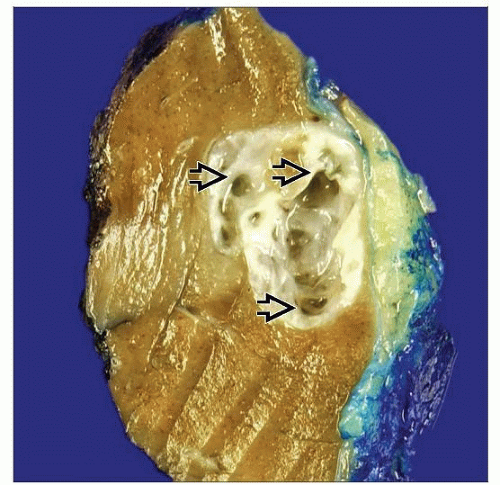Clear Cell Papillary Renal Cell Carcinoma
Satish K. Tickoo, MD
Victor E. Reuter, MD
Key Facts
Terminology
Carcinoma with exclusive clear cell cytology, low nuclear grade, papillary and tubular/acinar architecture, and nuclei in linear arrangement away from basal aspect of cells
Etiology/Pathogenesis
No 3p25.3 losses
No VHL gene mutations
No trisomies of chromosome 7 or losses of Y
Clinical Issues
Most tumors small, pT1stage
No lymph node or other metastases reported (as of now)
Biologically likely to be indolent tumor
Microscopic Pathology
Usually cystic
Usually prominent papillary architecture
Almost all cells with clear cytoplasm
Nuclei, almost always low grade
Nuclei arranged in linear alignment, away from basal aspect of cells, usually in center of cytoplasm or more apical
CK7(+), CA9(+), HMCK(34βE12)(+), CD10(-) or focally (+), AMACR(-)
Top Differential Diagnoses
Clear cell renal cell carcinoma
Papillary renal cell carcinoma
Translocation-associated renal carcinoma
TERMINOLOGY
Abbreviations
Clear cell papillary renal cell carcinoma (CC-PRCC)
Definitions
Carcinoma with exclusive clear cell cytology, low nuclear grade, papillary and tubular/acinar architecture, and nuclei in linear arrangement away from basal aspect of cells
ETIOLOGY/PATHOGENESIS
End-Stage Kidneys
Initially reported in end-stage renal disease, with reported caveat that these are also seen in non-end-stage setting ± without impaired renal function
Molecular Features
No 3p25.3 losses
No VHL gene mutations
No trisomies of chromosome 7 or losses of Y
1 case reported to have trisomy 17
CLINICAL ISSUES
Presentation
Initially reported in setting of end-stage renal disease, ± acquired cystic disease
Are also seen in non-end-stage setting
Unicentric, and occasionally multicentric, at presentation
Most tumors small, pT1 stage
Only rarely invading perinephric fat, pT3a
No lymph node or other metastases reported to date
Treatment
Surgical approaches
Due to size and nonaggressive radiologic appearance, usually partial nephrectomy
Prognosis
Biologically likely to be indolent tumor
MACROSCOPIC FEATURES
General Features
Well circumscribed
Usually encapsulated
Capsule variable in thickness
Variably, but often prominently, cystic
Size
Usually small
Mean size: 2.5 cm; largest described tumor: 5 cm in size
MICROSCOPIC PATHOLOGY
Histologic Features
Well circumscribed, often encapsulated
Capsule variable in thickness
Some cases with prominent myoid metaplasia of thick capsule with extensions into tumor mass
Usually cystic
However, some tumors are predominantly solid with very few cystic areas
Usually prominent papillary architecture
Some cases with tightly packed papillae giving rise to solid appearance
Tubular/acinar features are also common
Some tumors with tightly packed, very small “collapsed” acini, giving the tumor solid sheet-like appearance
Tumors with “collapsed” acini, variable tubular architecture, myoid metaplasia, and diffuse CK7 positivity are considered by some to be separate
tumor entities (renal angiomyoadenomatous tumor/RCC with diffuse CK7 immunoreactivity)
Such features maybe seen in otherwise typical clear cell papillary RCC
Therefore, no reason to consider these as separate tumors
Logical to accept these within the spectrum of clear cell papillary RCC
Foamy macrophages and tumor necrosis invariably absent
Almost all cells have clear cytoplasm
Except in solid “collapsed” acinar areas
Scanty cytoplasm in these areas makes cells appear somewhat amphophilic
Nuclei almost always low grade (equivalent to Fuhrman grade 2)
Most characteristic feature is arrangement of nuclei
Nuclei in linear arrangement, away from basal aspect of cells, usually in center of cytoplasm or more apical
ANCILLARY TESTS
Immunohistochemistry
CK7: Diffusely and strongly positive (almost always 100% of cells)
CA9: Diffusely positive
HMCK(34βE12): Often diffusely positive
AMACR: Negative
CD10: Negative or very focally positive
DIFFERENTIAL DIAGNOSIS
Clear Cell Renal Cell Carcinoma
Papillary areas uncommon
Random nuclear arrangement in cytoplasm
Usually strongly CD10 immunoreactive with diffuse membranous positivity; CK7(-)
Papillary Renal Cell Carcinoma
Optically transparent clear cytoplasm not seen; clear cells if present, finely bubbly, granular, and focal
Stay updated, free articles. Join our Telegram channel

Full access? Get Clinical Tree





